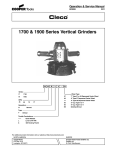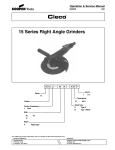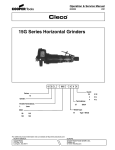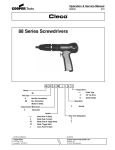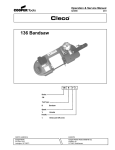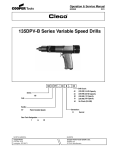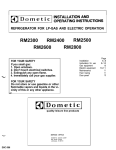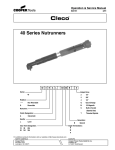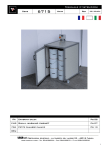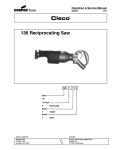Download Cooper 1700 Series Service manual
Transcript
Operation & Service Manual 823136 1/02 1700 & 1900 Series Horizontal Grinders XX XX H X - XX Series: 17 1700 19 1900 RPM: 45 60 Wheel Type: P 18 16 Plug 8" Type 1 6" Type 1 80 Type: H Horizontal Throttle Terminations: L S X Quick Release Lever (Lock Off) Self Closing Thumb Spade NORTH AMERICA EUROPE CooperTools P.O. Box 1410 Lexington, SC 29071 Cooper Power Tools GmbH & Co. Postfach 30 D-73461 Westhausen 1 Safety Recommendations For your safety and the safety of others, read and understand the safety recommendations before operating any grinder. ! WARNING Always wear protective equipment and clothing. Wear respirator where necessary. ! WARNING Impact resistant eye protection must be worn while operating or working near this tool. Caution: Faceshields do not provide unlimited protection against flying particles and are not to be considered as eye protection. ANSI Z87.1 states that separate eyewear shall be used. For additional information on eye protection, refer to Federal OSHA Regulations, 29 CFR, Section 1910.133, Eye and Face Protection, and ANSI Z87.1, Occupational and Educational Eye and Face Protection. This standard is available from the American National Standards Institute, Inc., 11 West 42nd Street, New York, NY 10036. ! CAUTION Personal hearing protection is recommended when operating or working near this tool. Hearing protection is recommended in high noise areas (above 85 dBA). Close proximity of additional tools, reflective surfaces, process noises, and resonant structures can substantially contribute to the sound level experienced by the operator. Excessive air pressure (greater than 90 psig) or worn components can also increase sound level emitted by the tool. Proper hearing conservation measures, including annual audiograms and training in the use and fit of hearing protection devices may be necessary. For additional information on hearing protection, refer to Federal OSHA Regulations, 29 CFR, Section 1910.95, Occupational Noise Exposure, and American National Standards Institute, ANSI S12.6, Hearing Protectors. • Gloves and other protective clothing should be worn as required. • Do not wear clothing that may restrict movement, become entangled or in any way interfere with the safe operation of grinders. Grinding or other use of this tool may produce hazardous fumes and/or dust. To avoid adverse health effects utilize adequate ventilation and/or a respirator. Respirators should be selected, fitted, used and maintained in accordance with Occupational Safety and Health Administration and other applicable regulations. Read the material safety data sheet of any materials involved in the grinding process. Cleco grinders are designed to operate on 90 psig (6.2 bar) max. air pressure. If the tool is properly sized and applied, higher air pressure is unnecessary. Excessive air pressure increases the loads and stresses on the tool parts and may result in breakage. Installation of a filter-regulator-lubricator in the air supply line is highly recommended. Never use the air hose for supporting, lifting, or lowering the tool. Use a safety line or cable on the tool when working in elevated areas. Before tool is connected to air supply, check throttle for proper operation, i.e., throttle moves freely and returns to closed position. Being careful not endanger adjacent personnel, clear air hose of accumulated dust and moisture. Use protective barriers where necessary — hot sparks can burn. Barriers also help reduce noise levels. Before removing tool from service or changing accessories, make sure air line is shut off and drained of air to prevent the tool from operating if the throttle is accidently engaged. The use of a self-relieving valve for this purpose is highly recommended. ! WARNING Do not operate without proper wheel guard in place. The wheel guard is designed to prevent serious injury to the operator in the event of wheel failure and must not be modified in any way. Any wheel guard that is damaged or bent must be replaced. NOTE: The grinder must be held so that the opening in the guard is away from the operator. 2 Safety Recommendations The guard must be securely attached to the grinder with all bolts, nuts and lockwashers in place and torqued to the specifications on page 6. 203208 Speed Rating and Warning Tag 0 Warning & Instruction Labels 202407 & 202408 1 2 WARNING ! OVER Repetitive work motions and/or vibration can cause injury to hands and arms. Use minimum hand grip force consistent with proper control and safe operation. Keep body and hands warm and dry. Avoid anything that inhibits blood circulation. Avoid continuous vibration exposure. Keep wrists straight. Avoid repeated bending of wrists and hands. CAUTION WARNING Hearing protection is recommended in high noise areas (above 85 dBA). Close proximity of other tools, reflective surfaces, process noises, and resonant structures can substantially contribute to the sound level experienced by the user. ! ! Personal hearing protection is recommended when operating or working near this tool. Impact resistant eye protection must be worn while operating or working near this tool. Read Operating Instructions carefully. Follow the Safety Recommendations for your safety and the safety of others. 6 4 5 Do not remove this tag until the operator of this tool has read these safety precautions. 3 869974 203011 WARNING TAG Warning Tag (or 203266 Plug Wheel Grinder) Causes of abrasive wheel failures have been traced to such factors as: • Dropping, bumping, or abuse (careless handling of the grinder or wheel) • Improper mounting • Imbalance • Improper shipment or storage • Exposure to water, solvents, high humidity, freezing and extreme temperatures • Mismatched speed ratings • Age Abrasive wheels known to have been subjected to any of the above conditions can burst violently. Never operate a vertical grinder without proper wheel guard in place. CHECK FLANGE The speed rating, warning tags and warning labels should be maintained or replaced for legibility in the event or damage. Speed rating, warning tags, and warning labels are available from the manufacturer. Before mounting a wheel, after all tool repairs, and whenever a grinder is issued for use, check the free speed of the grinder with a tachometer to make certain that the actual free speed at 90 psig (6.2 bar) does not exceed the rated free speed stamped on the tool. Grinders in use on the job must be similarly checked at least once every twenty hours of operation, or once every week, whichever is more frequent. Checking free speed after the removal of each worn wheel and before mounting a new wheel is highly recommended. INSPECT THE GRINDING WHEEL! Check the maximum safe RPM marked on the wheel. Never use a wheel rated below the actual tool speed. Inspect the wheel for cracks or chips, water stains, or signs of abuse or improper storage. Cracked, chipped or faulty grinding wheels are dangerous and must not be used. They must be destroyed rather than risk their use by someone who may not notice that they are damaged. ! WARNING Fragments from an abrasive wheel can cause serious injury or death. Do not operate without proper wheel guard in place. On Type 1 wheel grinders, the driving flanges must be the relieved-type, free of nicks and burrs or other flaws that might create stress concentrations on the grinding wheel. Spindles should be checked for damage or abuse. Blotters must be used and be at least as large in diameter as the flanges. Diameters of both driving flange and outer flange must be identical and both must measure at least one-third the diameter of the grinding wheel mounted between them. Both flanges must be properly relieved as per ANSI Safety Code B7.1. (See Page 6) On threaded hole cone wheels, the flange should be flat, unrelieved, and measure at least one-third the diameter of the cone or plug. Never use a relieved driving flange as it can pull the threaded insert out or the cone or plug. Spacers shall not be used between threaded hole wheels and back flanges. The blotter must be at least as large as the driving flange. (See Page 6) ABRASIVE WHEEL MOUNTING & BEGINNING GRINDING OPERATION The spindle end nut should be tightened firmly against the outer flange of Type 1 wheels to assure the necessary friction against the blotter faces to drive the wheel. ! CAUTION Overtightening can cause wheel breakage. Type 1 Wheel breakage can also occur if: • Outer flange is left off • Outer flange is reversed • A washer is used in place of proper flange • Outer flange and driving flange are of unequal diameters • No wheel blotters are used The cone or plug wheel must be seated against the driving flange to assure the necessary friction against the blotter to drive the wheel. The grinder spindle must be shorter than the hole in the cone or plug. Do not use spacers. 3 Safety Recommendations Before beginning operations or after mounting a wheel, the tool must be run for one (1) minute in a protected enclosure to check the integrity or the wheel. During this time or any other time, no one should stand in front of or in line of the wheel. When starting work with a cold wheel, apply it gradually to the workpiece until the wheel becomes warm. ! WARNING Extreme caution should be exercised not to use excessive side pressure. Excessive side pressure can break the wheel and result in severe injury. Guard not shown for clarity. GRINDING FACE Blotter Relieved flanges minimum 1/3 dia. of wheel dia. TYPE 1 WHEEL Do not grind with side of Type 1 wheel. DO NOT CONTINUE TO USE A GRINDER IF: • It is not equipped with the proper wheel guard • The speed rating of the wheel is less than the speed of the grinder • It starts to vibrate • You sense any changes in tool speed or an unusual increase in noise output that would indicate the tool is running at excessive speed. • You notice excessive end play in the spindle • You hear any unusual sound froom the grinder RETURN THE TOOL TO THE TOOL CRIB FOR SERVICE IMMEDIATELY! symptoms of tingling, numbness, blanching of fingers, clumsiness or weakened grip, nocturnal pain in the hand, or any other disorder of the shoulders, arms, wrists, or fingers is advised to consult a physician. If it is determined that the symptoms are job related or aggravated by movements and postures dictated by the job design, it may be necessary for the employer to take steps to prevent further occurrences. These steps might include, but are not limited to, repositioning the workpiece or redesigning the workstation, reassigning workers to other jobs, rotating jobs, changing work pace, and/or changing the type of tool used so as to minimize stress on the operator. Some tasks may require more than one type of tool to obtain the optimum operator/tool/ task relationship. The following suggestions will help reduce or moderate the effects of repetitive work motions and/or extended vibration exposure: • Use a minimum hand grip force consistent with proper control and safe operation • Keep body and hands warm and dry (cold weather is reported to be a major factor contributing to Raynaud's Syndrome) • Tasks should be performed in such a manner that the wrists are maintained in a neutral position, which is not flexed, hyperextended, or turned side to side • Avoid anything that inhibits blood circulation —Smoking Tobacco (another contributing factor) —Cold Temperatures —Certain Drugs Avoid ! W A R N I N G Repetitive work motions and/or vibration may cause injury to hands and arms. Use minimum hand grip force. Keep body and hands warm and dry. Avoid anything that inhibits blood curculation. Avoid continuous vibration exposure. Keep wrists straight. Avoid repeated bending of wrists and hands. Some individuals may be susceptible to disorders of the hands and arms when performing tasks consisting of highly repetitive motions and/or exposure to extended vibration. Cumulative trauma disorders such as carpal tunnel syndrome and tendonitis may be caused or aggravated by repetitious, forceful exertions of the hands and arms. Vibration may contribute to a condition called Raynaud's Syndrome. These disorders develop gradually over periods of weeks, months, and years. It is presently unknown to what extent exposure to vibrations or repetitive motions may contribute to the disorders. Hereditary factors, vasculatory or circulatory problems, exposure to cold and dampness, diet, smoking and work practices are thought to contribute to the conditions. Any tool operator should be aware of the following warning signs and symptoms so that a problem can be addressed before it becomes a debilitating injury. Any user suffering prolonged 4 Extension OK Neutral Avoid Flexion Avoid Radial Deviation OK Avoid Neutral Ulnar Deviation • Stressful postures should be avoided — select a tool appropriate for the job and work location • Avoid highly repetitive movements of hands and wrists, and continuous vibration exposure (after each period of operation, exercise to increase blood circulation) • Use quality abrasive wheels • Keep tool well maintained and replace worn parts Work gloves with vibration reducing liners and wrist supports are available from some manufacturers of industrial work gloves. Tool wraps and grips are also available from a number of different manufacturers. These gloves, wraps, and wrist supports are designed to reduce and moderate the effects of extended vibration exposure and repetitive wrist trauma. Since they vary widely in design, material, thickness, vibration reduction, and wrist support qualities, it is recommended that the glove, tool wrap, or wrist support manufacturer be consulted for items designed for your specific application. WARNING! Proper fit of gloves is important. Improperly fitted gloves may restrict blood flow to the fingers and can substantially reduce grip strength. Safety Recommendations WIRE BRUSHES If a grinder is used for wire brushing applications the same problems of balance, roundness, and trueness as experienced with abrasive wheels prevail. Use quality wire brushes. a good grade of 10W machine oil. Proper adjustment of the inline lubricator is performed by placing a sheet of paper next to the exhaust ports and holding the throttle open approximately 30 seconds. The lubricator is properly set when a light stain of oil collects on the paper. Excessive amounts of oil should be avoided. USE QUALITY ABRASIVE WHEELS STORAGE The primary source of vibration when using a portable grinder is an abrasive wheel that is out of balance, out of round, untrue, or possibly any combination of all three. The use of quality abrasive wheels which are well balanced, round, and true is highly recommended as they have been found to significantly reduce vibration. Some abrasive wheels lose their balance, roundness, and trueness as they wear from use. Because of the abusive nature of the vibration caused by out of balance, out of round, and untrue condition of some abrasive wheels, it is felt that these wheels are more susceptible to failure. Excessive vibration may signal eminent wheel failure. Flat spotting or the abrasive wheel, caused by grinding the wheel to a stop after the power has been shut off can result in changes to the balance and shape of the wheel. Be sure the grinding wheel has stopped before setting the tool down. Set the tool in a tool rest or tool holder when not in use. USE A PREVENTIVE MAINTENANCE PROGRAM Tool abuse or poor maintenance procedures can amplify and contribute to the vibration produced by the abrasive wheel. A preventive maintenance program featuring scheduled periodic inspections and proper maintenance is the best way to assure safety in your portable grinding operations. A well managed program can, for example, detect such things as speed variations due to wear, flanges or spindles that have been damaged from abuse, or bad bearings damaged by foreign matter or lack of lubrication. Problems such as these can affect the wheel trueness when the grinder is running and contribute to the vibration. Rotor blades that are worn or chipped can lock up motor and result in grinding wheel spinoff and should be replaced. Rotor blades should be checked periodically and replaced if they measure less than 7/16" (11mm) at either end. Replace if 7/16" (11mm) or less at either end. PROPER LUBRICATION An automatic in-line filter-regulator-lubricator is recommended as it increases tool life and keeps the tool in sustained operation. The in-line lubricator should be regularly checked and filled with In the event that it becomes necessary to store the tool for an extended period of time (overnight, weekend, etc.), it should receive a generous amount of lubrication at that time and run for several seconds to distribute the oil before disconnecting from the air supply. This will reduce the possibility of corrosion and displace any water that may be trapped in the tool. Water trapped in the tool could cause the governor to freeze and malfunction if tool is exposed to freezing temperatures. Note: Water in the air system increases tool maintenance costs and can cause the tool to malfunction when it is stored and/or operated in freezing conditions. Proper repair procedures and the use of original Cleco service parts and bearings rather than substitutes will return the tool to factory specifications of precision and balance, and minimize vibration. The governor should be checked periodically to be sure the governor mechanism is clean, in good operating condition, and functioning properly. The 1700 and 1900 Series grinders are equipped with the CLECO SHUT-OFF disc which is designed to shut the tool down in the event of excessive overspeed. It is not to be considered a substitute for a wheel guard. If the tool fails to run it may be due to the overspeed shut-off disc. After the problem causing excessive overspeed has been corrected, the disc must be reset by clicking it to its normal position. This information is a compilation of general safety practices obtained from various sources available at the date of production. However, our company does not represent that every acceptable safety practice is offered herein, or that abnormal or unusual circumstances may not warrant or require additional procedures. Your work may require additional specific safety procedures. Follow these procedures as required by your company. For more information, see the latest edition of ANSI B186.1, Safety Code for Portable Air Tools, and ANSI B7.1 Safety Requirements for the Use, Care, and Protection of Abrasive Wheels available from the American National Standards Institute, Inc., 11 West 42nd Street, New York, NY 10036. 5 6 OPERATING INSTRUCTIONS READ SAFETY RECOMMENDATIONS BEFORE CONNECTING TOOL. The 1700 Series Grinders are designed to operate on 90 psig (6.2 bar) maximum air pressure, using a 3/4" hose up to 8' in length. If additional length is required, the next larger hose size may be connected to the 8' whip hose. The 1900 Series Grinders are designed to operate on 90 psig (6.2 bar) maximum air pressure, using a 3/4" hose up to 8' in length. If additional length is required, the next larger hose size may be connected to the 8' whip hose. LUBRICATION An automatic in-line filter-lubricator is recommended as it increases tool life and keeps the tool in sustained operation. The in-line lubricator should be regularly checked and filled with a good grade of 10W machine oil. Proper adjustment of the inline lubricator is performed by placing a sheet of paper next to the exhaust ports and holding the throttle open approximately 30 seconds. The lubricator is properly set when a light stain of oil collects on the paper. Excessive amounts of oil should be avoided. STORAGE In the event that it becomes necessary to store the tool for an extended period of time (overnight, weekend, etc.), it should receive a generous amount of lubrication at that time and run for several seconds to distribute the oil before disconnecting from the air supply. SERVICE INSTRUCTIONS DISASSEMBLY-GENERAL Disconnect the tool from the air supply and remove the grinding wheel and guard from the front of the tool. REMOVING THE MOTOR UNIT FROM THE MOTOR HOUSING: Insert a 5/16" hex wrench (clamped in a vise) in the spindle shaft and unscrew the driving flange. Removing the housing bolts will allow the governor housing 867832, to be removed from the housing. Remove the motor unit from the rear of the motor housing. DISASSEMBLY OF THE MOTOR UNIT: Unscrew the governor assembly (left hand threads) from the rear of the motor unit. Clamping on the cylinder, hold the motor unit in the vise with the rear bearing plate up. Using a soft 1/4" (6.5mm) rod and a suitable hammer, drive the rotor shaft out of the overspeed shut-off disc and rear rotor bearing, 869820. This will allow the various motor unit components to be removed from the rotor. IMPORTANT NOTE: The overspeed shut-off disc is an assembly and must not be disassembled. Do not remove the disc seal plate unless the rear bearing plate needs to be replaced. DISASSEMBLY OF THE GOVERNOR: Remove the governor pin retainer, No. 867770, and using a 3/32" (2mm) punch, drive out the governor weight pins, No. 413050. After removing the weights and two washers, the governor cone pin, No. 413047, may be driven out using the 3/32" (2mm) punch. It is important that a new governor cone pin is used during reassem- bly of the governor (SEE GOVERNOR REASSEMBLY). Unscrewing the governor adjusting nut, No. 867767, will allow the removal of the governor spring. THROTTLE HANDLE MAINTENANCE: Should the throttle valve seal, No. 869539, need replacing, unscrew the throttle valve cap, No. 867753, for removal of the throttle valve and components. The tool is equipped with two (2) air screens for protection of the internal motor parts from foreign material. The air screen located in the inlet bushing may be removed for cleaning and inspection by unscrewing the inlet bushing, No. 867758. If the screen is torn or damaged, the inlet bushing should be replaced. The air screen, No. 867729, located between the throttle handle and motor housing may be removed for cleaning and inspection by unscrewing the two (2) socket head cap screws, No. 813041. If the screen cannot be cleaned or if it is torn, it should be replaced. REASSEMBLY—GENERAL The tool is reassembled in the reverse order of disassembly. All parts should be thoroughly cleaned and inspected before reassembly. Particular attention should be paid to the rotor blades and rotor bearings as failure of these parts could cause damage to more expensive components. Rotor blades should be replaced at every repair cycle or if they measure 7/16" (11mm) or less at either end (See Fig. 1). Rotor bearings should be replaced if they are rough or show excessive looseness. Replace if 7/16" (11mm) or less at either end. Fig. 1 MOTOR UNIT REASSEMBLY: During reassembly of the motor unit, the rotor must be positioned by the front rotor collar, No. 869608, so that when assembled, the rotor will have .0015" (.038mm) to .0025" (.063mm) clearance between it and the front bearing plate. Install the front rotor bearing, No. 869818, in the front bearing plate, No. 869814, and measure the depth of the bearings inner race from the face of the bearing plate. Select, or fit by sanding, a rotor collar .0015" (.025mm) to .0025" (.062mm) larger than this dimension (See Fig. 2). SELECT OR SAND ROTOR COLLAR TO THIS MEASUREMENT PLUS .0015" (.038mm) FRONT BEARING PLATE INNER RACE OF BEARING ROTOR COLLAR .OO15" (.038mm) Clearance FRONT BEARING PLATE INNER RACE OF BEARING Fig. 2 7 Slip the assembled front bearing plate onto the rear of the spindle shaft until it is retained by the step diameter. Now install the rotor collar and with a suitable driver (.670" (17mm) ID minimum) resting against the rotor collar, drive home the front bearing plate assembly until it stops against the spindle shoulder. NOTE: Check the rpm rating etched on the disc against the rpm rating stamped on the tool; they must be the same. Now install the rotor key, No. 412967, into the keyway in the shaft. This will allow the rotor, four (4) rotor blades, and cylinder to be installed on the shaft. See Fig. 3 for correct installation of the rotor and rotor blades. During reassembly, a new governor cone pin, No. 413047, should be installed and both ends of the pin should be upset to secure it. The governor cone, No. 413048, should be checked to be sure that it moves freely on the governor spider, No. 869099, after installation of the cone pin. Motor Air Inlet Cylinder Pin Edge of blade must be installed as shown Housing Exhaust Rear View of Motor in Housing Fig. 3 Now install the rear rotor collar, No. 867749, rear bearing plate, No. 869819, and rear rotor bearing, No. 869820, (drive on the bearing’s inner race.) When installing the driving flange, No. 869809, it should be torqued to 50-60 ft. lbs (68-81 Nm). If the front spindle bearing, No. 867789, is replaced, the new bearing should be pressed (press on the stamped end of the bearing) into the motor housing to a depth of 9/16" plus or minus 1/64" (14.2mm plus or minus .39mm). The spring washer, No. 869817, should be assembled in the housing with its large diameter against the motor housing (cone side up). Refer to Fig. 3 and install the motor unit in the motor housing as shown. This will allow the exhaust slots in the cylinder to be properly located in relation to the housing exhaust for minimum noise levels. Assemble the driving flange to the spindle and tighten securely. Check the fit between the governor weights and governor weight pins, No. 413050, and replace all parts that show excessive wear. Install the governor spring on the governor spider being sure the tang on the spring engages the hole in the spider. Screw the governor adjusting nut, No. 867767, on the governor screw approximately six (6) turns. Final speed adjustment is made after the tool is completely assembled using governor adjustment wrench, No. 867739. IMPORTANT: After the governor is completely assembled, install it (left hand threads) on the rear of the rotor shaft and torque to 40/45 ft. lbs. (54-61 Nm). In cases where a torque wrench is not available, the governor should be hand tightened to a snug position, then tightened by going beyond the hand tight condition 180°. The “O”-ring, No. 834619, and governor housing, No. 867832, may now be installed to complete reassembly of the motor unit. OVERSPEED SHUT-OFF DISC DRIVER ROTOR SHAFT BEARING Fig. 3 Assemble the “O”-ring, No. 865520, onto the disc seal plate, No. 867765, and press the seal plate, No. 867765, (undercut side up) onto the rear bearing plate. FINAL SPEED ADJUSTMENT Check the free speed of the tool with a dependable tachometer with the grinding wheel removed. Before reassembly, the overspeed shut-off disc should receive a close inspection for wear and/or damage. To make an adjustment, turn the air supply off and remove (using a 1/8" hex wrench) the spindle plug, No. 612211, and insert the governor adjustment wrench, No. 867739, to engage the governor adjustment nut, No. 867767. A clockwise adjustment will increase the rpm and a counterclockwise adjustment will decrease the rpm. Replace the spindle plug before turning the air supply on. Check the rated rpm of the tool stamped on the governor housing and set free speed accordingly. IMPORTANT ASSEMBLY INSTRUCTIONS: The complete overspeed shut-off disc assembly must be assembled to the spindle shaft using a suitable flat-driver (7/8" (22.5mm O.D. min.) resting against the assembly and driven down until it stops against the rear bearing inner race (See Fig. 4). 8 During reassembly of the governor, it is imperative that all parts be clean and free of foreign material. HORIZONTAL GRINDERS HOUSING & MOTOR UNIT Driving Flange Wheel Size Flange O.D. 6"x1"x5/8" (150mm x 25mm x 16mm) 2" (50mm) 8"x1"x5/8" (200mm x 25mm x 16mm) 3" (75mm) 8"x1"x1" (200m x 25mm x 25mm) 3" (75mm) 843846 Part No. 867799 867818 202005 867790 867789 867788 Outer Flange Wheel Size Flange O.D. Part No. 6" (150mm) 2' (50mm) 847047 8" (200mm) 3' (75mm) 842724 1700 869825 1900 869826 1700 867794 1900 867828 202020 844287 203011 842341 612211 1700 869824 1900 869828 1700 867776 1900 867825 1700 867744 1900 867821 869818 202020 203208 847548 869820 412967 Governor Assembly (See Page 10) OFF 869817 Part No. 202005 202020 203011 203208 412967 612211 842341 842724 843846 844287 847047 847548 867742 867744 867749 867776 867788 867789 867790 869819 867749 869529 1700 867742 863925 1900 867826 Overspeed Shut-off Disc Available and Related Components Rotor Collars (See Page10) Part No. Thickness 867749 .1515" - .1510" 869601 .1500" - .1495" 869600 .1485" - .1480" 869814 Name of Part 8" Wheel Driving Flange (8x11) Drive Screw Warning Tag Instruction Plate Rotor Key Spindle Plug Hex Nut 8" Wheel Outer Flange Spindle End Nut (5/8-11NC) Lock Washer 6" Wheel Outer Flange Cylinder Pin Rotor-1700 Rotor Blade-1700 Rotor Collar (.1515"/.1510") Cylinder-1700 (incl. 847548) Bearing Race Spindle Needle Bearing Dust Shield Qty. Part No. 1 6 1 1 1 1 4 1 1 4 1 1 1 4 2 1 1 1 1 867794 867799 867818 867821 867825 867826 867828 869529 869600 869601 869814 869817 869818 869819 869820 869824 869825 869826 869828 Name of Part Housing Bolt-1700 6" Wheel Driving Flange 8" Wheel Driving Flange Rotor Blade-1900 Cylinder (incl. 847548) Rotor-1900 Housing Bolt-1900 Governor Housing (incl. 202020,203208) Rotor Collar (.1485"/.1480") Rotor Collar (.1500"/.1495") Front Bearing Plate Spring Washer Front Rotor Bearing Rear Bearing Plate Rear Rotor Bearing Spindle (5/8-11NC)-1700 Motor Housing-1700 Motor Housing-1900 Spindle (5/8-11NC) -1900 Qty. 4 1 1 4 1 1 4 1 1 1 1 1 1 1 1 1 1 1 1 9 HORIZONTAL GRINDERS GOVERNOR & SHUT-OFF DISC 413048 Part No. Name of Part 204187 x RPM 204187 413047 Quantity 4 6 8 5 0 0 0 0 0 0 0 0 GOVERNOR WEIGHT 869099 204187 RPM PART NO. DIMENSION-X 4,500 413270 3/4" (19mm) 6,000 413270 3/4" (19mm) 8,000 413210 1/2" (12.7mm) 413050 204187 F OF 867770 GOVERNOR SPRING RPM PART NO. COLOR 4,500 413041 GREEN 6,000 413042 NONE 8,000 413041 GREEN 867767 204187 413041 413042 413047 413048 413050 413210 413270 867767 867770 869099 Washer Governor Spring (Green) Governor Spring (No Color) Governor Cone Pin Governor Cone Governor Weight Pin Governor Weight Governor Weight Governor Adjusting Nut Governor Pin Retainer Governor Spider 4 1 1 1 2 2 1 1 1 4 1 1 1 2 2 1 1 1 4 1 1 1 2 2 1 1 1 COMPLETE GOVERNOR ASSEMBLY NO. PART NO. RPM 861545 861546 861547 4,500 6,000 8,000 OVERSPEED SHUT-OFF DISC RPM 4,500 PART NO. 869834 6,000 8,000 869835 869837 PART LIST OVERSPEED SHUT-OFF DISC AND RELATED COMPONENTS PART NO. 865520 867765 869834 869835 869837 865520 NAME OF PART QTY. "O"-Ring 2-1/4" x 2-3/8" Disc Seal Plate 4,500 RPM Overspeed Shut-off Disc 6,000 RPM Overspeed Shut-off Disc 8,000 RPM Overspeed Shut-off Disc 1 1 1 1 1 IMPORTANT NOTE: The RPM rating and part number are etched on the surface of the disc. 867765 OPTIONAL EQUIPMENT PARTS LIST - MUFFLER ASSEMBLY MUFFLER PART NO. 1700 1900 1700 1900 1700 1900 202113 202114 867947 867948 867945 867943 202112 202113 202114 867943 867945 867947 867948 NAME OF PART Muffler Screw (self tapping) Muffler (incl. 867947) Muffler (incl. 867948) Baffle Plate Baffle Plate Muffler Gasket Muffler Gasket QTY. 2 1 1 1 1 1 1 The complete muffler assembly can be purchased as a subassembly: 202112 1700 Part No. 861996 1900 Part No. 861997 INSTALLATION PROCEDURE: The muffler is installed on the tool by aligning the muffler assembly over the exhaust and screwing the two (2) self-tapping screws into the mating exhaust holes. 10 HORIZONTAL GRINDERS HANDLE SUBASSEMBLIES LOCK OFF LEVER HANDLE NAME OF PART 413056 413255 415330 812977 813041 833961 844323 844912 845228 845322 861009 864195 864582 864620 867729 867731 867732 867753 867755 867756 867758 867768 867769 867793 867803 869429 869539 869838 869839 883729 Throttle Valve Spring Lever Bushing Self Closing Thumb Throttle Lever Stop Pin Socket Head Cap Screw "O"-Ring 13/16" x 1" "O"-Ring 1-1/4" x 1-1/2" Lock Washer Throttle Lever Pin Pawl Pin Throttle Valve (incl. 869539) Throttle Lever Pin Spade Throttle Lever Pawl Spring Air Screen Pawl "O"-Ring 1-1/8" x 1-5/16" Throttle Valve Cap Throttle Pin Throttle Pin Bushing Inlet Bushing Quick Release Thumb Throttle Lock Off Lever Throttle Pin Throttle Handle (incl. 867756) Throttle Pin Throttle Valve Seal Throttle Handle (incl. 867756) Throttle Handle (incl. 867756) Throttle Lever Screw 867769-2 845228-6 845322-7 867731-2 867758-5 867732-0 864620-0 867756-9 844323-6 867729-6 813041-1 844912-6 869839-1 869429-1 869539-7 413056-3 867753-6 833961-6 861009-9 SELF CLOSING THUMB LEVER & QUICK RELEASE THUMB LEVER HANDLE 883729 Self Closing Thumb Throttle 415330 Quick Release Thumb Throttle 867768 413255 867758 867732 867756-9 844323 867729 813041 844912 869838 867755 869539 413056 861009 867753 833961 LOCK OFF LEVER HANDLE 812977 864195 867803 844323 864582 QTY. PART NO. S. C. T H U Type M Handle B 1 1 1 2 1 1 2 1 1 1 1 1 1 1 1 1 1 Q. R. T H U M B L. O. L E V E R S P A D E 1 1 2 1 1 2 1 1 1 1 1 1 1 1 1 1 1 1 2 1 1 2 1 1 1 1 1 1 1 1 1 1 1 1 1 1 1 - 1 1 2 1 1 2 1 1 1 1 1 1 1 1 1 1 1 - *Denotes parts not included in subassemblies listed Be- 867729 813041 844912 867758 867732 867756 867793 869539 861009 413056 867753 833961 low. The complete throttle handles can be purchased as a subassembly using the code numbers listed below. Self Closing Thumb Throttle - 861898 Quick Release Thumb Throttle - 861897 Lock Off Lever Throttle - 861896 Spade Throttle - 861566 11 CooperTools 670 Industrial Drive Lexington, SC 29072 Phone: (803) 359-1200 Fax: (803) 359-2013 www.cooperindustries.com 12












